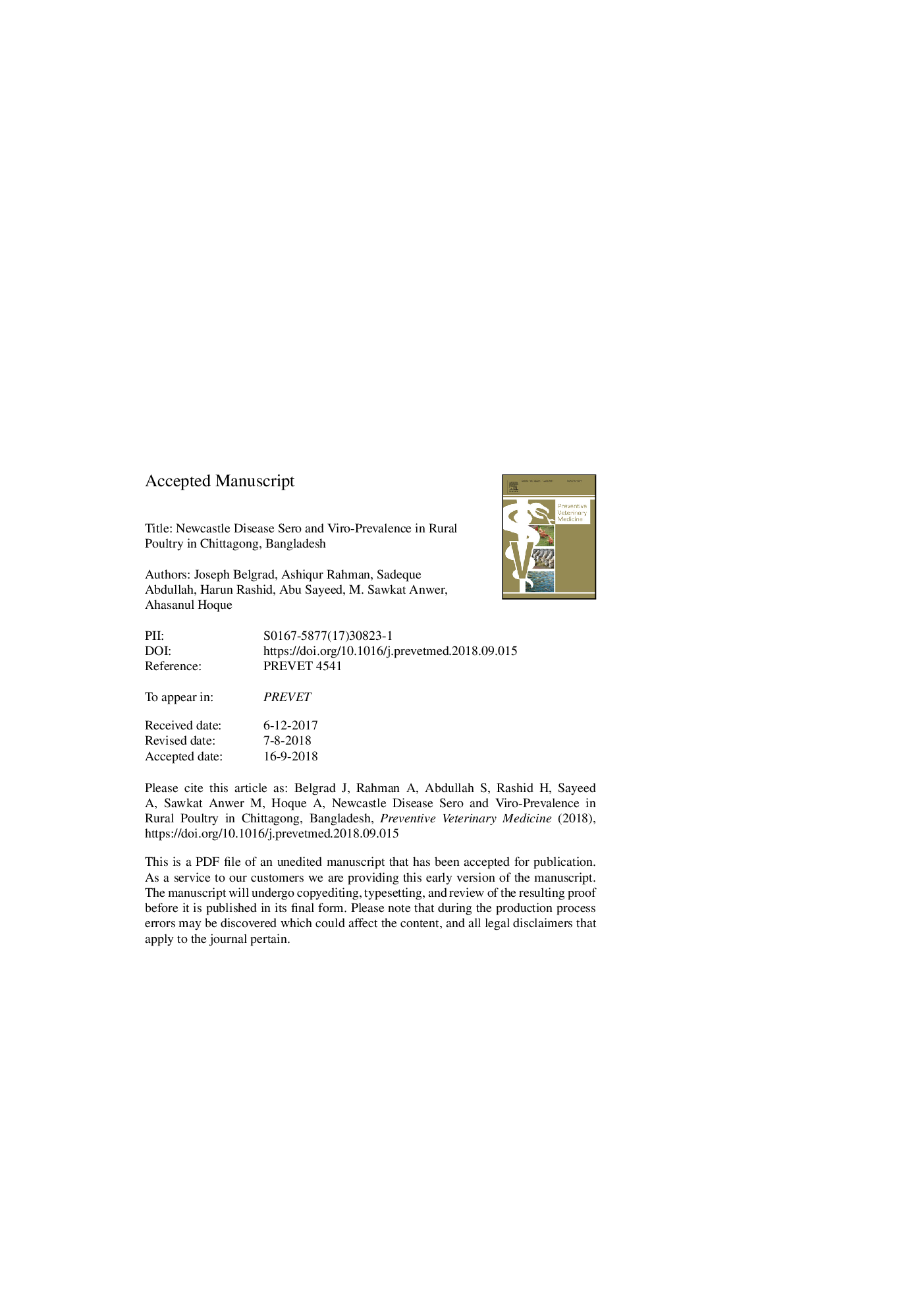| کد مقاله | کد نشریه | سال انتشار | مقاله انگلیسی | نسخه تمام متن |
|---|---|---|---|---|
| 11019402 | 1718109 | 2018 | 28 صفحه PDF | دانلود رایگان |
عنوان انگلیسی مقاله ISI
Newcastle disease sero and viro-prevalence in rural poultry in Chittagong, Bangladesh
ترجمه فارسی عنوان
بیماری نیوکاسل سرم و ویروس شایع در مرغ های روستایی در چیتاگونگ، بنگلادش
دانلود مقاله + سفارش ترجمه
دانلود مقاله ISI انگلیسی
رایگان برای ایرانیان
کلمات کلیدی
مرغ های روستایی، چیتاگنگ، بنگلادش، بیماری نیوکاسل، شیوع،
موضوعات مرتبط
علوم زیستی و بیوفناوری
علوم کشاورزی و بیولوژیک
علوم دامی و جانورشناسی
چکیده انگلیسی
Bangladesh experiences some of the highest malnutrition rates in the world, and efforts are being made to increase food security and overall health status. One of the largest constrains on increasing food security is endemic diseases among livestock and poultry populations. Newcastle Disease (ND) is one of these viral endemic diseases reducing food security. However, the sero- and viro-prevalence of ND has not been thoroughly studied in rural poultry in Bangladesh. Knowledge of farm management practices and their effect on ND sero and viro-prevalence is needed before interventions can occur, and efforts to improve the endemic state of ND cannot begin without a baseline study. This cross-sectional study randomly sampled 129 rural households with 245 chickens for the sero-prevalence and active infection rate of rural chickens in two selected upazilas (sub-districts) of the Chittagong district. ELISA was used for the detection of sero-prevalence, and cloacal samples were analyzed for ND presence using one-step RT-PCR. The aims of this study were to describe farmer demography, determine the ND sero-prevalence at the household and individual chicken level, estimate the proportionate ND prevalence at the individual chicken level, determine potential risk factors for ND sero-prevalence at the household level, and determine challenges farmers face with household chicken farming. The overall household level ND sero-prevalence based on ELISA was 31.8% (41/129) (95% CI: 23.9-40.6%), whereas the overall bird level ND sero-prevalence based on ELISA was 21.2% (52/245) (95% CI: 16.5-26.8%). ND prevalence based on RT-PCR was 12.5% (4/32) (95% CI: 3.5-29.0%). The odds of ND sero-positivity was significantly higher in farms belonging to Rangunia than in farms belonging to Anowara with an odds ratio (OR) of 7.8 (95% CI: 3.3-18.6%). The odds of ND sero-positivity was significantly lower in poultry house cleaning frequency of once or twice weekly compared with once daily cleaning (ORâ=â0.3; 95% CI: 0.1-0.8%). High cleaning frequency may produce excessive stress on poultry predisposing them to infection. Poultry rearing is different between Anowara and Rangunia. Anowara (coastal) scavenging areas become restricted because of regular tide flow allowing small fishes and other aquatic animals to be the dominant scavengers in Anowara. The incoming tide also removes viral reservoirs such as feces and dead birds that may otherwise be readily accessed by healthy chickens.
ناشر
Database: Elsevier - ScienceDirect (ساینس دایرکت)
Journal: Preventive Veterinary Medicine - Volume 160, 15 November 2018, Pages 18-25
Journal: Preventive Veterinary Medicine - Volume 160, 15 November 2018, Pages 18-25
نویسندگان
Joseph P. Belgrad, Md. Ashiqur Rahman, Md. Sadeque Abdullah, Md. Harun Rashid, Md. Abu Sayeed, M. Sawkat Anwer, Md. Ahasanul Hoque,
